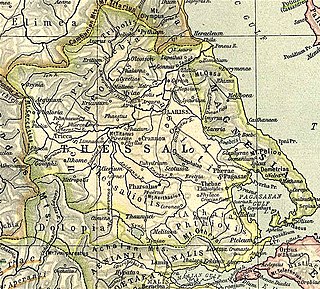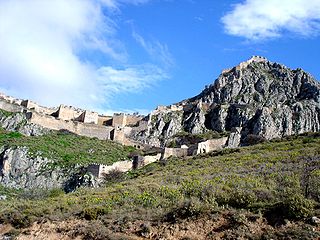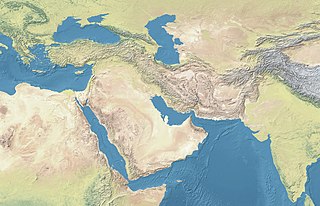
Volos is a coastal port city in Thessaly situated midway on the Greek mainland, about 330 kilometres north of Athens and 220 kilometres south of Thessaloniki. It is the capital of the Magnesia regional unit. Volos is the only outlet to the sea from Thessaly, the country's largest agricultural region. With a population of 144,449 (2011), it is an important industrial centre, while its port provides a bridge between Europe, the Middle East and Asia.

The Pagasetic Gulf is a rounded gulf in the Magnesia regional unit that is formed by the Mount Pelion peninsula. It is connected with the Euboic Sea. The passage into the Euboic Sea is narrow and is about 4 km.

Pagasae or Pagasai also Pagasa was a town and polis (city-state) of Magnesia in ancient Thessaly, situated at the northern extremity of the bay named after it.

Acrocorinth, "Upper Corinth", the acropolis of ancient Corinth, is a monolithic rock overseeing the ancient city of Corinth, Greece. "It is the most impressive of the acropoleis of mainland Greece," in the estimation of George Forrest. Acrocorinth was continuously occupied from archaic times to the early 19th century. Along with Demetrias and Chalcis, the Acrocorinth during the Hellenistic period formed one of the so-called "Fetters of Greece" - three fortresses garrisoned by the Macedonians to secure their control of the Greek city-states. The city's archaic acropolis, already an easily defensible position due to its geomorphology, was further heavily fortified during the Byzantine Empire as it became the seat of the strategos of the thema of Hellas and later of the Peloponnese. It was defended against the Crusaders for three years by Leo Sgouros.

Alexandria in Arachosia was a city in ancient times that is now called Kandahar in Afghanistan. It was one of more than seventy cities founded or renamed by Alexander the Great. Arachosia is the Greek name of an ancient province of the Achaemenid, Seleucid and Parthian empires. The province of Arachosia was centred around the Argandab valley in Kandahar, Afghanistan. It did not reach the Hindu Kush, but it apparently extended east as far as the Indus river, although its exact extents are not yet clear.

Rhizus or Rhizous was a town and polis of Magnesia in ancient Thessaly, whose inhabitants were transported by Demetrios Poliorketes to Demetrias upon the foundation of the latter city. We learn from Periplus of Pseudo-Scylax that Rhizus was outside the Pagasaean Gulf upon the exterior (Aegean) shore. In Strabo's time, it was a village dependent on Demetrias. Coins minted by Rhizus have been found, dated in the 4th century BCE.
Demetrias was a Hellenistic city in Assyria, near Arbela. It was probably founded by Demetrius I Soter, in commemoration of his victory over the rebel Timarchus of Babylon, in 160 B.C. It was located at the bank of Tigris and minted its own bronze coinage with the inscription ΔΗΜΗΤΡΙΕΩΝ ΤΩΝ ΠΡΟΣ ΤΩΙ ΤΙΓΡΕΙ,, with the figures of Tyche and a tripod.

Boebe or Boibe was a city of Magnesia in ancient Thessaly, mentioned by Homer in the Catalogue of Ships, and situated on the eastern side of the lake, called after it Boebeis Lacus. The lake is frequently mentioned by the ancient writers, but the name of the town rarely occurs.

Iolcus is an ancient city, a modern village and a former municipality in Magnesia, Thessaly, Greece. Since the 2011 local government reform it is part of the municipality Volos, of which it is a municipal unit. It is located in central Magnesia, north of the Pagasitic Gulf. Its land area is 1.981 km². The municipal unit is divided into three communities, Agios Onoufrios, Anakasia and Ano Volos, with a total population of 2,138. The seat of the former municipality was the village of Ano Volos.
The name of a goddess worshiped as local cult in certain places of Greece in classical and Hellenistic period. It has been assumed that it was a cult of a chthonic Aphrodite or Artemis. Sanctuaries of Pasikrata have been found in Demetrias (Thessaly), Ambrakia (Epirus) and in Heracleia (Macedonia). The latter had slaves and hierodouloi at its disposition.
The name is considered the female equivalent of Pankrates (omnipotent), attributed to Hercules.

Nelia or Neleia was a town of Magnesia in ancient Thessaly; Demetrias was situated between it and Iolcus. Strabo reports that when Demetrios Poliorketes founded Demetrias he moved the population of Nelia thither (293 BCE).

In the ancient Greek city of Demetrias in Thessaly, funerary stelai showed an assortment of mythological scenes, battle scenes, and more, all using the art styles of the Hellenistic period. Stelai in Ancient Greece were used almost in the same manner as modern tombstones, commemorating the dead. They were made of stone or marble, mainly. They often either showed scenes from the deceased's life, or a mythological scene. The use of stelai in Ancient Greece have been observed dating back to the bronze age.

Metropolis was a town in Perrhaebia in Ancient Thessaly. Stephanus of Byzantium calls it simply a town in Thessaly, distinct from its more-renowned namesake. This appears to be the Metropolis mentioned by Livy in his account of the campaign of Antiochus III, in 191 BCE, where it is related that the Syrian king having landed at Demetrias, first took Pherae, then Crannon, then Cypaera, Metropolis, and all the neighbouring fortresses, except Atrax and Gyrton, and afterwards proceeded to Larissa. From this account it would appear that this Metropolis was in Perrhaebia; and its site has been discovered by William Martin Leake, near that of Atrax, at Kastri village in the municipal unit of Lakereia, where the name of Μητροπολίτης occurs in an inscription.

Anciently, Magnesia was a region of Ancient Greece, eventually absorbed by ancient Thessaly. Originally inhabited by the Magnetes (Μάγνητες), Magnesia was the long and narrow slip of country between Mounts Ossa and Pelion on the west and the sea on the east, and extending from the mouth of the Peneius on the north to the Pagasaean Gulf on the south. The Magnetes were members of the Amphictyonic League, and were settled in this district in the Homeric times, and mentioned in the Iliad. The Thessalian Magnetes are said to have founded the Asiatic cities of Magnesia ad Sipylum and Magnesia on the Maeander. The towns of Magnesia were: Aesonis, Aphetae, Boebe, Casthanaea, Cercinium, Coracae, Demetrias, Eurymenae, Glaphyrae, Homole or Homolium, Iolcus, Magnesia, Meliboea, Methone, Mylae, Nelia, Olizon, Pagasae, Rhizus, Spalaethra, and Thaumacia.
Ormenium was a town of ancient Thessaly, mentioned in the Catalogue of Ships in Homer's Iliad, along with Hypereia and Asterium, as belonging to Eurypylus. In Greek mythology, it was said to have been founded by Ormenus, the grandson of Aeolus, and was the birthplace of Phoenix. Strabo identifies this town with a place in Magnesia named Orminium, situated at the foot of Mt. Pelion near the Pagasaean Gulf, at the distance of 27 stadia from Demetrias, on the road passing through Iolcus, which was 7 stadia from Demetrias and 20 from Orminium. William Martin Leake, however, observes that the Ormenium of Homer can hardly have been the same as the Orminium of Strabo, since it appears from the situation of Asterium that Eurypylus ruled over the plains of Thessaliotis, which are watered by the Apidanus and Enipeus. The questioning of Strabo's equation of Ormenium with Orminium is still the norm among current scholars; some believing that, instead, Ormenium should be close to Pharsalus, in a Mycenaean site in modern Ktouri. Some archaeologists have related it to the remains found on the Goritsa hill. Others point to a site otherwise called Armenium at Petra. While others leave the site as unlocated.
Orminium or Orminion was a town of Magnesia in ancient Thessaly. Strabo say that Orminium is situated at the foot of Mt. Pelion near the Pagasaean Gulf, at the distance of 27 stadia from Demetrias, on the road passing through Iolcus, which was 7 stadia from Demetrias and 20 from Orminium.







